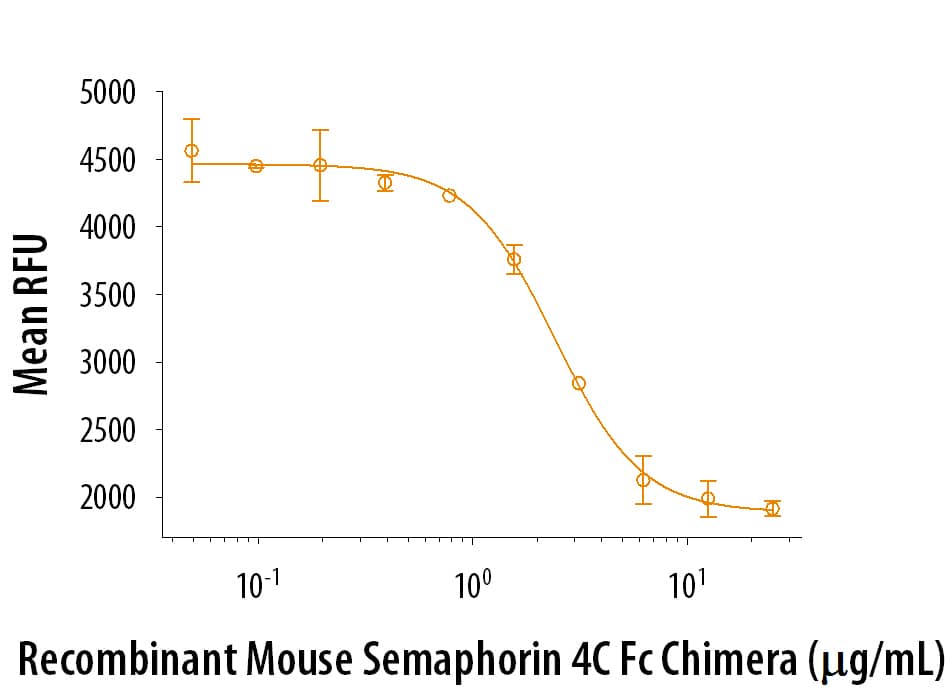Recombinant Mouse Semaphorin 4C Fc Chimera Protein, CF
R&D Systems, part of Bio-Techne | Catalog # 8394-S4

Key Product Details
Source
NS0
Accession #
Structure / Form
Disulfide-linked homodimer
Conjugate
Unconjugated
Applications
Bioactivity
Product Specifications
Source
Mouse myeloma cell line, NS0-derived mouse Semaphorin 4C protein
| Mouse Semaphorin 4C (Ala21-Gly664) Accession # Q64151 |
IEGRMDP | Mouse IgG2a (Glu98-Lys330) |
| N-terminus | C-terminus |
Purity
>95%, by SDS-PAGE visualized with Silver Staining and quantitative densitometry by Coomassie® Blue Staining.
Endotoxin Level
<0.10 EU per 1 μg of the protein by the LAL method.
N-terminal Sequence Analysis
Ala21
Predicted Molecular Mass
99 kDa
SDS-PAGE
105-125 kDa, reducing conditions
Activity
Measured by its ability to inhibit survival of SK-OV-3 human ovarian carcinoma cells.
The ED50 for this effect is 1.5-7.5 μg/mL.
The ED50 for this effect is 1.5-7.5 μg/mL.
Scientific Data Images for Recombinant Mouse Semaphorin 4C Fc Chimera Protein, CF
Recombinant Mouse Semaphorin 4C Fc Chimera Protein Bioactivity
Recombinant Mouse Semaphorin 4C (Catalog # 8394-S4) inhibits survival of SK‑OV‑3 human ovarian carcinoma cells. The ED50 for this effect is 1.5-7.5 μg/mL.Formulation, Preparation and Storage
8394-S4
| Formulation | Lyophilized from a 0.2 μm filtered solution in Citric Acid and NaCl, pH 5.0 |
| Reconstitution |
Reconstitute at 200 μg/mL in PBS.
|
| Shipping | The product is shipped at ambient temperature. Upon receipt, store it immediately at the temperature recommended below. |
| Stability & Storage | Use a manual defrost freezer and avoid repeated freeze-thaw cycles.
|
Background: Semaphorin 4C
References
- Tessier-Lavigne, M. and C.S. Goodman (1996) Science 274:1123.
- Wu, H. et al. (2009) J. Mol. Neurosci. 39:27.
- Wang, L. et al. (1999) J. Biol. Chem. 274:14137.
- Inagaki, S. et al. (1995) FEBS Lett. 370:269.
- Worzfeld, T. et al. (2004) Eur. J. Neurosci. 19:2622.
- Perala, N. et al. (2010) Dev. Dyn. 239:2722.
- Friedel, R.H. et al. (2007) J. Neurosci. 27:3921.
- Maier, V. et al. (2011) Mol. Cell. Neurosci. 46:419.
- Deng, S. et al. (2007) J. Neurosci. 27:6333.
- Swiercz, J.M. et al. (2004) J. Cell. Biol. 165:869.
- Perala, N. et al. (2011) Differentiation 81:81.
- Zielonka, M. et al. (2010) Exp. Cell Res. 316:2477.
- Shirvan, A. et al. (1999) J. Neurochem. 73:961.
- Guttman-Raviv, N. et al. (2007) J. Biol. Chem. 282:26294.
Alternate Names
SEMA4C, SEMACL1, Semaf, SEMAI
Gene Symbol
SEMA4C
UniProt
Additional Semaphorin 4C Products
Product Documents for Recombinant Mouse Semaphorin 4C Fc Chimera Protein, CF
Product Specific Notices for Recombinant Mouse Semaphorin 4C Fc Chimera Protein, CF
For research use only
